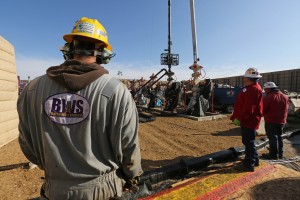New study shows gas workers could be exposed to dangerous levels of benzene
-
Susan Phillips

Brennan Linsley / AP
Workers keep an eye on well heads during a hydraulic fracturing operation at an Encana Corp. oil well, near Mead, Colo.
A new study out this month reveals unconventional oil and natural gas workers could be exposed to dangerous levels of benzene, putting them at a higher risk for blood cancers like leukemia. Benzene is a known carcinogen that is present in fracking flowback water. It’s also found in gasoline, cigarette smoke and in chemical manufacturing. As a known carcinogen, benzene exposures in the workplace are limited by federal regulations under OSHA. But some oil and gas production activities are exempt from those standards.
The National Institute of Occupational Health and Safety (NIOSH) worked with industry to measure chemical exposures of workers who monitor flowback fluid at well sites in Colorado and Wyoming. A summary of the peer-reviewed article was published online this month on a CDC website. In several cases benzene exposures were found to be above safe levels.
The study is unusual in that it did not simply rely on air samples. The researchers also took urine samples from workers, linking the exposure to absorption of the toxin in their bodies. One of the limits of the study includes the small sample size, only six sites in two states.
Dr. Bernard Goldstein from the University of Pittsburgh School of Public Health says the study is the first of its kind. Goldstein did not contribute to the study’s research, but he has conducted his own research on benzene. And he’s treated patients exposed to the carcinogen.
“These workers are at higher risk for leukemia,” said Goldstein. “The longer, the more frequently they do this, the more likely they are to get leukemia particularly if the levels are high.”
The study looked at workers who use a gauge to measure the amount of flowback water that returns after a frack job is initiated. A spokeswoman for NIOSH says none of their studies draw any conclusions about exposures to nearby residents, but focus specifically on workers.
But Dr. Goldstein says it shows that there could be potential risks to residents as well.
“We’re not acting in a way to protect the public who are at high risk,” said Goldstein. “And we can’t even tell you who is at high risk. Yet we’re rushing ahead in a situation where all of the data are telling us that there are risks.”
He urges a similar study should take place in Pennsylvania.
“These are the kind of studies that should be done,” said Goldstein. “It should have been done a long time before this. They’re first being done now. They must be done in Pennsylvania.”
A spokeswoman for an industry group says there is always room for improvement if toxic exposures exist.
“[The study represents] a small sample size,” said Katie Brown with the group Energy In Depth. “It is limited in that respect. I think that’s the whole reason for this partnership is to study it and see how [drillers] can improve.”
Authors of the NIOSH benzene study said that more research with larger sample sizes should be done, especially since there was so much variation in the levels observed at different times and well sites. The researchers also listed a number of recommendations for industry to take to reduce benzene levels on the job site. These include changing tank gauging procedures, training workers, limiting exposure times, carrying gas monitors, using respiratory and hand protection, and monitoring exposure levels.
















